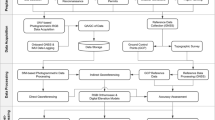Abstract
Unmanned aerial vehicle (UAV) could wirelessly transfer power to the devices on ground, thus recharging their batteries conveniently. Nevertheless, the efficiency of this wireless power transfer from UAV to ground remains unclear. This paper aims to answer this question from the theoretical perspective. We need two models for this purpose: an energy harnessing model and a UAV-to-ground wireless channel model. In the literature, a model of harnessing radio frequency (RF) energy and turning it into DC power is available. Our goal is to quantify the theoretical efficiency of RF-to-DC power conversion, and the amount of DC power gained as a result. Following this nonlinear energy harvesting circuit model, the signal level fluctuations caused by channel fading actually enhance the power conversion. To model the wireless channel gain from the UAV to the ground, we use the modified Loo’s channel model. Connecting it to the RF-to-DC power conversion model, we can determine the theoretical amount of DC power attainable from UAV’s transmission, in addition to its power conversion efficiency. Our finding shows that a heavy shadowing condition can enhance the RF-to-DC power conversion of a nonlinear energy harvesting circuit. For example, certain heavy shadowing condition may yield a conversion efficiency that is 7 dB higher than when shadowing is absent. This concurs with the previous finding that signal attenuation and fluctuation actually made the energy easier to be captured and harnessed by the nonlinear rectenna circuitry. Our finding confirms that high RF-to-DC conversion efficiency is attainable even under shadowing conditions.



Similar content being viewed by others
Availability of data and material
Not applicable.
Code availability
Not applicable.
Abbreviations
- Λ:
-
Path loss
- \(\tilde{r}(t)\) :
-
Normalized received complex envelope
- \(\hat{r}\) :
-
Magnitude of the normalized received complex envelope
- \(P_{{{\text{RF}}}}\) :
-
Effective RF power level (W) at the input of an energy harvester
- \(P_{{\text{RF, Np}}}\) :
-
Effective RF power level (Nepers) at the input of an energy harvester
- \(P_{{\text{DC, no fading}}}\) :
-
DC power produced under the condition of no fading
- \(e_{{{\text{fading}}}}\) :
-
Channel gain from fading
- \(\varepsilon_{{\text{no fading}}}\) :
-
RF-to-DC conversion efficiency in the absence of fading
- \(\varepsilon_{{{\text{fading}}}}\) :
-
RF-to-DC conversion efficiency in the presence of fading
- a :
-
Amplitude of the direct/coherent component
- A :
-
\(20\lg a\) in dB
- \({\rm M}_{A}\) :
-
Mean of A in dB
- \(\Sigma_{A}\) :
-
Standard deviation of A in dB
- I 0 :
-
Zero-order modified Bessel function of the first kind
- γ:
-
Average multipath/diffuse component power
- \(\Gamma\) :
-
\(10\lg (\gamma )\) in dB
- \({\rm M}_{\Gamma }\) :
-
Mean of Г in dB
- \(\Sigma_{\Gamma }\) :
-
Standard deviation of Г in dB
References
Park, J., Lee, H., Eom, S., & Lee, I. (2019). UAV-aided wireless powered communication networks: Trajectory optimization and resource allocation for minimum throughput maximization. IEEE Access, 7, 134978–134991. https://doi.org/10.1109/ACCESS.2019.2941278
Hu, Y., Yuan, X., Xu, J., & Schmeink, A. (2019). Optimal 1D trajectory design for UAV-enabled multiuser wireless power transfer. IEEE Transactions on Communications, 67(8), 5674–5688. https://doi.org/10.1109/tcomm.2019.2911294
Nguyen, M. N., Nguyen, L. D., Duong, T. Q., & Tuan, H. D. (2019). Real-time optimal resource allocation for embedded UAV communication systems. 8(1), 225–238. https://doi.org/10.1109/LWC.2018.2867775
Wang, H., Wang, J., Ding, G., Wang, L., Tsiftsis, T. A., & Sharma, P. K. (2018). Resource allocation for energy harvesting-powered D2D communication underlaying UAV-assisted networks. IEEE Transactions on Green Communications and Networking, 2(1), 14–24. https://doi.org/10.1109/TGCN.2017.2767203
Na, Z., Zhang, M., Wang, J., & Gao, Z. (2020). UAV-assisted wireless powered internet of things: Joint trajectory optimization and resource allocation. Ad Hoc Networks, 98, 102052. https://doi.org/10.1016/j.adhoc.2019.102052
Clerckx, B., & Kim, J. (2018). On the beneficial roles of fading and transmit diversity in wireless power transfer with nonlinear energy harvesting. IEEE Transactions on Wireless Communications, 17(11), 7731–7743. https://doi.org/10.1109/TWC.2018.2870377
Loo, C. (1985). A statistical model for a land mobile satellite link. IEEE Transactions on Vehicular Technology, 34(3), 122–127. https://doi.org/10.1109/T-VT.1985.24048
Simunek, M., Fontán, F. P., & Pechac, P. (2013). The UAV low elevation propagation channel in urban areas: Statistical analysis and time-series generator. IEEE Transactions on Antennas and Propagation, 61(7), 3850–3858. https://doi.org/10.1109/TAP.2013.2256098
Funding
Not applicable.
Author information
Authors and Affiliations
Corresponding author
Ethics declarations
Conflict of interest
On behalf of all authors, the corresponding author states that there is no conflict of interest.
Additional information
Publisher's Note
Springer Nature remains neutral with regard to jurisdictional claims in published maps and institutional affiliations.
Rights and permissions
About this article
Cite this article
Foo, YL. Wireless power transferable from unmanned aerial vehicle. Telecommun Syst 78, 589–594 (2021). https://doi.org/10.1007/s11235-021-00834-6
Accepted:
Published:
Issue Date:
DOI: https://doi.org/10.1007/s11235-021-00834-6




